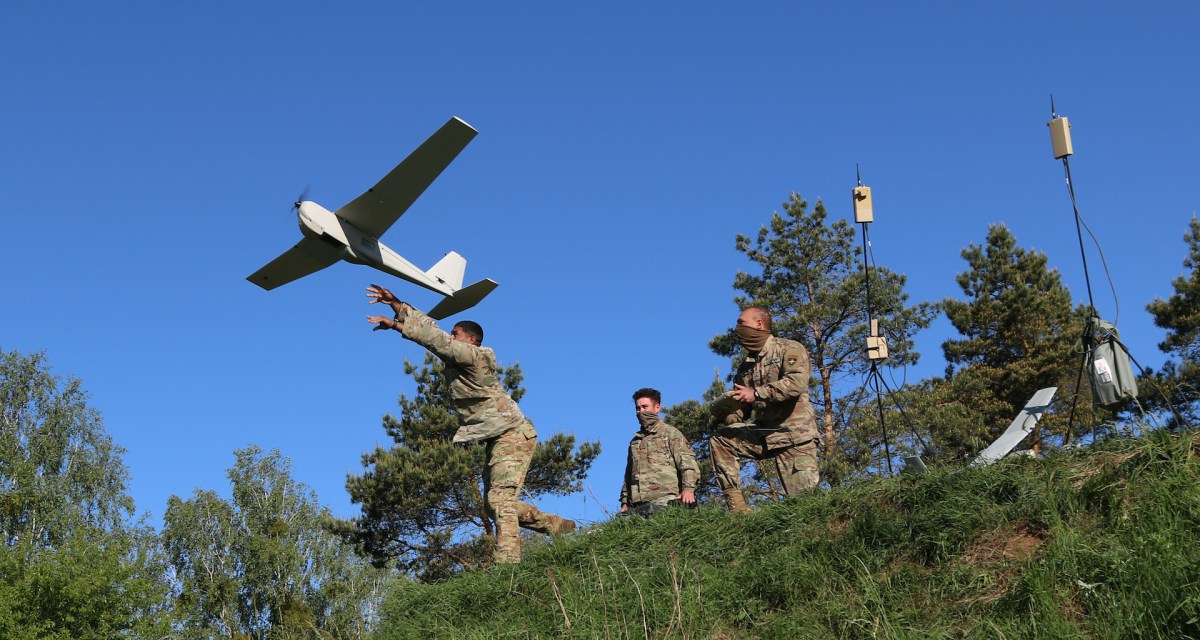Army working to team up its autonomous systems across domains with AI

Army Futures Command is working to string “teammates” of multiple unmanned systems together with artificial intelligence-enabled data sharing, the command’s top general, John “Mike” Murray, said Wednesday.
Murray’s comments on the work being done by the command’s AI Task Force come as it is starting to see more funding for its projects. Stationed at Carnegie Mellon University, the task force has been working on teaming manned/unmanned systems, but linking multiple unmanned systems together has been discussed less publicly.
Pairing multiple unmanned systems together “is key,” the general said. The goal is to get systems like flying drones and autonomous ground vehicles “talking to each other,” he added during a virtual event with Association of United States Army.
Teaming is a part of the Army’s push into multi-domain operations, where forces are coordinated across domains like air, land, sea, cyber and space to create tactical advantages on the battlefield, Murray said.
The Army’s top officer, Gen. James McConville, previously told Congress the service is “aggressively pursuing” maned/unmanned teamed systems and that pairing multi-domain autonomous systems was also in the works to “better utilize [their] capabilities.” Barriers to bringing each idea to life remain. The Army has been promising to deliver autonomous ground systems across the force for years, with minimal success.
The Army AI’s Task Force is also developing a DevSecOps environment for its machine learning algorithms. To keep its code secure, it’s working to adopt best practices from the private sector on software development security, Murray said.
Putting money where its mouth is
Fresh research on defense spending shows that the Army’s autonomous systems saw recent spikes in AI-related funding. The analysis by Govini — which used its own machine learning and AI-enabled research tools to compare recent years of defense spending and the president’s fiscal 2021 budget request — found that across fiscal years 2016-17 and fiscal years 2018-19, Army research and development obligations for advanced autonomous systems increased from $61.8 million to $177.2 million, an 187% rise.
While the research numbers are increasing, spending on other aspects of advanced autonomous systems is likely to decrease, the report found. The White House’s 2021 budget request would shrink it in the Army to below $4 billion from $4.6 billion in fiscal 2020. Murray added that he expects the top-line defense budget to either stay level or possibly shrink due to coronavirus-related spending, triggering hard choices for how he will allocate his modernization and long-term development resources.
“We are probably not going to see real growth” in the coming years, Murray said.
‘In the future everything is going be a sensor’
Developing autonomous systems that can coordinate across domains is a part of the Army’s “Project Convergence,” which aims to achieve battlefield advantage through multi-domain operations. It is the ground force’s version to the Air Force’s Advanced Battle Management System family of technologies and Joint All Domain Operations doctrine. The core tech behind enabling each service’s multi-domain desires is a common data architecture that can process information in real time to connect “every sensor to every shooter,” as the common saying goes.
For Murray, he wants to not only connect every sensor to every shooter, but prepare for a military internet of things where “everything is going to a be a sensor.” That will include everything from autonomous systems to the tips of the weapons they will deploy being a sensor generating data to be digested. Preparation for that reality means hardening network security and doing the type of work the AI task force is now focusing on with unmanned/unmanned teaming systems, Murray said.
Right now, “Convergence” is a noun in Murray’s vocabulary. “What we are trying to do is take that noun and turn it into a verb,” he said.




